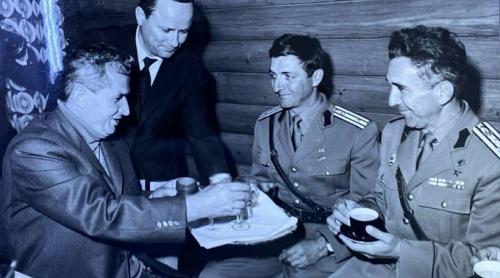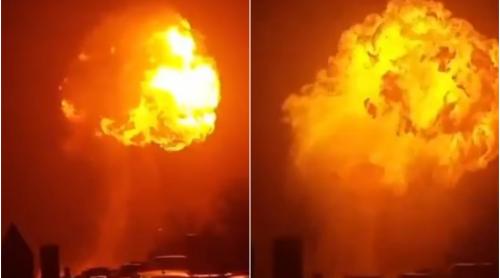
By the middle of the 1700s, the 13 colonies that made up part of England's empire in the New World were finding it difficult to be ruled by a king 3,000 miles across the Atlantic Ocean. They were tired of the taxes imposed upon them. But independence was a gradual and painful process. The colonists could not forget that they were British citizens and that they owed allegiance to King George III.
A "tea party" and a Massacre" were two events that hurried destiny. Along with general unrest these events united the colonists. In 1767 a tea company in India, owned by England, was losing money. To save the company, England levied a tax on tea sold in the colonies in 1773. Partly as a joke, Samuel Adams and other Bostonians dressed up as Indians and dumped a cargo of the India Company Tea into the Massachusetts Bay. King George III did not think it was funny, nor did he lift the tax on tea. In the Boston harbor, British soldiers were jeered and stoned by colonists who thought the soldiers had been sent to watch them. The soldiers fired into the crowd and killed a few citizens. The colonists exaggerated the number killed and called it a massacre.
Virginia took the first step toward independence by voting to set up a committee to represent the colonies. This First Continental Congress met in September of 1774. They drew up a list of grievances against the crown which became the first draft of a document that would formally separate the colonies from England. George Washington took command of the Continental Army and began fighting the British in Massachusetts. For the next eight years, colonists fought fervently in the Revolutionary War.
In the meantime, a war of words was being waged in Philadelphia, Pennsylvania. On July 2, 1776, the Second Continental Congress presented & debated a second draft of the list of grievances, and John Hancock, the president of the Second Continental Congress, was the first to sign. The document, called the Declaration of Independence, was treasonous against the crown and the fifty-six men who signed it were in danger of being executed.
Independence Day is celebrated on July 4 because that is the day when the Continental Congress adopted the final draft of the Declaration of Independence*. From July 8, 1776, until the next month, the document was read publicly and people celebrated whenever they heard it. The next year, in Philadelphia, bells rang and ships fired guns, candles and firecrackers were lighted. But the War of Independence dragged on until 1783, and in that year, Independence Day was made an official holiday. 1941 Congress declared 4th of July a federal holiday.
*Except for the U.S. Virgin Islands where celebrations are held a week prior to the climax on 4th of July.
John Adams, a lawyer, the first Vice President and the Second President of the United States, was one of the members of the Second Continental Congress who signed the Declaration of Independence. He wrote to his wife, "I believe that it will be celebrated by succeeding generations as the great anniversary festival... it ought to be celebrated by pomp and parade, with shows, games, sports, guns, bells, bonfires and illuminations from one end of this continent to the other..."
John Adams may have predicted the later Independence Day celebrations or perhaps he started traditions with his words. Every July fourth, Americans have a holiday from work. Communities have day-long picnics with favorite foods like hot dogs, hamburgers, potato salad, baked beans and all the fixings. The afternoon activities would not be complete without lively music, a friendly baseball game, three-legged races and a pie-eating or watermelon-eating contests. Some cities have parades with people dressed as the original founding fathers who march in parades to the music of high school bands. At dusk, people in towns and cities gather to watch the fireworks display. Wherever Americans are around the globe, they will get together for a traditional 4th of July celebration!
The Declaration of Independence was first read in Philadelphia, Pennsylvania. Today, at the Freedom Festival at Independence Hall, costumed Americans re-enact historical scenes and read the Declaration of Independence for the crowd. In Flagstaff, Arizona, American Indians hold a three-day pow-wow around the Fourth of July, with a rodeo and dancing. In Lititz, Pennsylvania, hundreds of candles that were made during the year are lighted in the park at night and floated in the water while a "Queen of Candles" is chosen. The ship U.S.S. John F. Kennedy comes in full sail to Boston Harbor in Massachusetts on the Fourth of July, and the Boston Pops Orchestra plays a musical concert of patriotic songs as more than 150,000 people watch fireworks burst over the water.
The Fireworks Family
New Castle, Pennsylvania, is home to the Vitale Fireworks Display Company, responsible for more than one thousand fireworks shows every year. In 1922 Constantino Vitale brought his expertise at making fireworks from Italy to the United States. He passed his secrets on to his four sons, and since then the company has been making Americans exclaim "ooohhh" and "aaahhhh" at the lighted colors in the sky on July 4 and other occasions. "It's like putting on a ballet show except that the dancers were above, painting the sky," says Vitale's granddaughter. "Seeing that spectacular display in the sky made me really love the country."Liberty Bell
The sight and sound of a ringing bell represents freedom to most Americans because of the Liberty Bell that rang in Philadelphia when the new country was born. In 1752 the new bell arrived safely from England, but at the first blow from a hammer to test it, it cracked. Not wanting to delay by returning the bell to England, the officials ordered bell founders in Philadelphia to remedy the fault. Two times it was recast before it was finally ready. On July 8, 1776, the bell rang to mark the occasion of the adoption of the Declaration of Independence. On April 16, 1783 it proudly announced the proclamation of peace and the newly won independence of the United States of America.At every event of national importance, the Liberty Bell joined its harmonious tones to the general acclaim: in 1789, the election of George Washington; in 1797, the election of John Adams; in 1799, the death of Washington; and in 1801, the election of Thomas Jefferson. On July 4, 1826, the bell was nearly three quarters of a century old, and the nation whose birth it had helped to announce was now a lusty youngster of 50. Joyous indeed was the bell's sound on that occasion.
Then, on July 8, 1835, while tolling for the funeral procession of John Marshall, Chief Justice of the Supreme Court and one of the signers of the Declaration of Independence, the great bell cracked.
Fearing that the crack would eventually destroy the historic bell, officials ordered it taken down from the tower. It was after this that the Liberty Bell received its name. Since then, the bell has been on display but has never rung. In fact, no one living knows the voice of the Liberty Bell, for it has never spoken since 1835. The crack which appeared on that occasion is prevented from widening by a mechanical device, called a spider, installed inside the bell.
A few years ago the bell foundry in London that originally cast the great bell made a friendly proposal - to ship the bell back to England, melt it, and recast it at no cost to the United States. The keepers of the bell considered the offer very seriously before giving an answer. Then they decided that the cracked liberty bell is a cherished symbol of America's struggle for freedom. Just as a man's facial lines and creases are a visible sign of the stress and strain he has survived, so the crack in the Liberty Bell serves to remind Americans that their forefathers did not win liberty for their country and its people without strain and stress - and even extensive fractures. Therefore, on behalf of the American people, the officials thanked the London foundry for its generous offer, but refused, adding: "We like the bell as it is, crack and all. It is an important part of our heritage."
Yankee Doodle
The song "Yankee Doodle Dandy" expresses European perceptions of the colonials. It reflects the supposed backwardness of America, typified by the long life of the three-cornered tricorne (and also by the fact that in 1775, most of Washington's army showed up in its everyday work clothes with men wearing handkerchiefs on their heads)."Yankee Doodle Dandy" began before the Revolution, though. When the colonial forces supported the British at Niagara during the French and Indian War (1754-1763), the Britsâalways very natty in their red uniforms (later, red targets)âwere amused by the colonials' backwoods appearance and sang about it. "Macaroni," the most bemusing word in "Yankee Doodle Dandy," refers to the fact that Italy and France were centers of European haute couture. The joke was that a colonialâa Yankee "dandy"âwould stick a feather in his tricorne or coonskin cap and think himself as fashionable as any man à la mode in Paris or Rome.
A British surgeon, Dr. Richard Schuckberg, is credited with writing down "Yankee Doodle Dandy" after the French and Indian War. When the American War of Independence broke out, the song gained popularity with British troops because it derided the provinciality of colonial culture and speech (there are around 190 verses that poke great fun).
America, the Beautiful
Every so often a movement is started to make "America the Beautiful" the national anthem instead of "The Star-Spangled Banner," largely because it was not written as a result of a war. The tune is easier to sing and the whole country is praised, not only the flag. Katherine Lee Bates, an English professor at Wellesley College, rode in a horse-drawn wagon up Pike's Peak, a mountaintop-in Colorado in 1893. She saw a view of the mountains that few people saw in those days and was inspired by her glimpse the "spacious skies" and "purple mountains" to write a poem, which became the first verse of the song. The public loved the poem, and Miss Bates Katherine Lee Bates was encouraged to set it to music She chose the music of a hymn by Samuel Ward. The words and music traveled around the world, and today Mexico, Canada and    Australia sing it with their own countries' names instead of "America."The Star Spangled Banner
On Sept. 13, 1814, Francis Scott Key visited the British fleet in Chesapeake Bay to secure the release of Dr. William Beanes, who had been captured after the burning of Washington, DC. The release was secured, but Key was detained on ship overnight during the shelling of Fort McHenry, one of the forts defending Baltimore. In the morning, he was so delighted to see the American flag still flying over the fort that he began a poem to commemorate the occasion. First published under the title "Defense of Fort M'Henry," the poem soon attained wide popularity as sung to the tune "To Anacreon in Heaven." The origin of this tune is obscure, but it may have been written by John Stafford Smith, a British composer born in 1750. "The Star-Spangled Banner" was officially made the national anthem by Congress in 1931, although it already had been adopted as such by the army and the navy.Parades, Marching Bands and Music
Parades, which usually begin mid-morning, are the first tradition followed each Fourth of July. The small-town parade, with baseball teams, baton twirlers and the high school marching band, is a common sight in cities across the country. Fathers hoist toddlers up on their shoulders for a clear view, while children munch popcorn and wave small flags. It's a fun, inspiring way to get into a patriotic mood.An important note:
When heading to and from parades, family members' houses or the beach, don't forget that traffic will be heavy. Leave extra time to get where you are going, and be extra aware of pedestrians, rollerbladers and bike riders.
Fireworks
When the parades are over and everyone's fingers are licked clean, the best is still yet to comeâthe fireworks display.Fireworks are one of the oldest and most stunning ways to commemorate America's birthday. Frequently the nation's colorsâred, white and blueâare used in these spectacular displays of patriotism.
Most large cities in the United States have at least one, if not several, fireworks displays on the night of the Fourth. Although watching the display from an apartment or office is likely to provide a clear view, most agree that the loud booms and crackles are necessary for proper fireworks enjoyment. For a real treat, relax on a blanket and snack on some munchies.
The crowds, the noise and the spectacular displays all combine to provide an exciting evening for children and adults alike. Fireworks are a remarkable and satisfying conclusion to the Fourth of July holiday.
Delicious Traditions
The key ingredient to any Fourth of July cookout or picnic is simplicity. There is something compelling about the smell of food being cooked over a charcoal pit, open flame or barbecue that seems to link us to the holiday's roots as well as our own ethos.The male figure of the family, beverage in hand (usually alcoholic), fussing with meat on the grill is a common sight in many American backyards on the Fourth of July.
While menus may have become more exotic (reflecting the diversity of the cultures which have made America home), and the activities more elaborate (if less patriotic), the main theme is enjoyment of the freedom to partake of "life, liberty and the pursuit of happiness."
In a very real sense, this celebration has retained its intent and origin. Even though not consciously called to mind by most, it still is a profound and human expression of independence and how essential it is to all.
Menus
The Fourth of July has become synonymous with the barbecue, outdoor cooking and summer fun. While variations are as numerous as the stars in the sky, there are still dishes and foods which immediately come to mind when one thinks of Independence Day. Below is a sample menu suitable for between 12-20 people, depending on their appetite.
Â
On this day in 1776, the Declaration of Independence was approved by the Continental Congress, starting the 13 colonies on the road to freedom as a sovereign nation. As always, this most American of holidays will be marked by parades, fireworks and backyard barbecues across the country.
2.5 million
In July 1776, the number of people living in the colonies. (1776 population from Historical Statistics of the United States: Colonial Times to 1970.)
302 million
The nationâs population on this July Fourth.
Fourth of July Cookouts
More than 1 in 4
The chance that the hot dogs and pork sausages consumed on the Fourth originated in Iowa. The Hawkeye State had a total of 15.5 million market hogs and pigs on March 1. This represents more than one-fourth of the nationâs total. North Carolina (8.4 million) and Minnesota (6.2 million) were the runners-up. http://www.nass.usda.gov
6.8 billion pounds
Total production of cattle and calves in Texas in 2006. Chances are good that the beef hot dogs, steaks and burgers on your backyard grill came from the Lone Star State, which accounted for about one-sixth of the nationâs total production. And if they did not come from Texas, they very well may have come from Nebraska (4.8 billion pounds) or Kansas (4.1 billion pounds). http://www.nass.usda.gov
6
Number of states in which the revenue from broiler chickens was $1 billion or greater between December 2005 and November 2006. There is a good chance that one of these states â Georgia, Arkansas, Alabama, North Carolina, Mississippi or Texas â is the source of your barbecued chicken. http://www.nass.usda.gov
About 50-50
The odds that the beans in your side dish of baked beans came from Michigan or North Dakota, which produced 49 percent of the nationâs dry, edible beans in 2006. Another popular Fourth of July side dish is corn on the cob. Florida, California, Georgia and New York together accounted for 60 percent of the sweet corn produced nationally in 2006. http://www.nass.usda.gov
Please Pass the Potato Salad
Potato salad and potato chips are popular food items at Fourth of July barbecues. Nearly half of the nationâs spuds were produced in Idaho or Washington in 2006. http://www.nass.usda.gov
More than 70 percent
Amount of the nationâs head lettuce production in 2006 that came from California. This lettuce may end up in your salad or on your hamburger.
About 2 in 3
The chances that the fresh tomatoes in your salad came from Florida or California, which combined accounted for 68 percent of U.S. tomato production last year. The ketchup on your hamburger or hot dog probably came from California, which accounted for 95 percent of processed tomato production in 2006. http://www.nass.usda.gov
Florida
The state that led the nation in watermelon production last year (835 million pounds). Other leading producers of this popular Fourth of July dessert include California, Georgia and Texas, each with more than 600 million pounds. http://www.nass.usda.gov
More than 74 million
Number of Americans who said they have taken part in a barbecue during the previous year. Itâs probably safe to assume a lot of these events took place on Independence Day.
See Table 1225, 2007 edition: http://www.census.gov/prod/www/statistical-abstract.html
Fireworks $206.3 million
The value of fireworks imported from China in 2006, representing the bulk of all U.S. fireworks imported ($216 million). U.S. exports of fireworks, by comparison, came to just $22.6 million in 2006, with Japan purchasing more than any other country ($8 million). http://www.census.gov/foreign-trade/www/
$17.3 million
The value of U.S. manufacturersâ shipments of fireworks in 2002. http://www.census.gov/prod/ec02/ec0231i325998t.pdf
Flags 5.3 million
In 2006, the dollar value of U.S. imports of American flags; the vast majority of this amount ($5 million) was for U.S. flags made in China. http://www.census.gov/foreign-trade/www/
$1.7 million
Dollar value of U.S. flags exported in 2006. Trinidad and Tobago was the leading customer, purchasing $661,498 worth. http://www.census.gov/foreign-trade/www/
$349.2 million
Annual dollar value of shipments of fabricated flags, banners and similar emblems by the nationâs manufacturers, according to the latest published Economic Census (2002) data. http://www.census.gov/prod/ec02/ec0231i314999t.pdf
Patriotic-Sounding Names
30
Number of places nationwide with "liberty" in its name. The most populous one is Liberty, Mo. (29,042). Iowa, with four, has more of these places than any other state: Libertyville, New Liberty, North Liberty and West Liberty.
â¢Â   Thirty-two places are named "eagle" â after the majestic bird that serves as our national symbol. (Places include cities, towns, villages and census-designated places.) The most populous such place is Eagle Pass, Texas, with 25,571 residents. There is also Eagle County, Colo., with a population of 49,085.
â¢Â   Eleven places have "independence" in their name. The most populous of these is Independence, Mo., with 110,208 residents.
â¢Â   Five places adopted the name "freedom." Freedom, Calif., with 6,000 residents, has the largest population among these.
â¢Â   There is one place named "patriot" â Patriot, Ind., with a population of 195.
â¢Â   And what could be more fitting than spending the Fourth of July in a place called "America"? There are five such places in the country, with the most populous being American Fork, Utah, population 21,372. (Sources:
The British are Coming!
$99 billion
Dollar value of trade last year between the United States and the United Kingdom, making the British, our adversary in 1776, our sixth-leading trading partner today. http://www.census.gov/foreign-trade/www/
Online Links to Independence Day
- Â Making Sense of The Fourth of July
- Â http://usinfo.state.gov/usa/infousa/facts/symbols/sense.htm
- Today in History: July 4
- http://memory.loc.gov/ammem/today/jul04.html
- Photo Galleries
- http://usinfo.state.gov/photogallery/index.php?album=%2FJuly_4&
- Fourth of July Celebrations Database
- http://american.edu/heintze/fourth.htm
- White House Independence Day page, 2005
- http://www.whitehouse.gov/independenceday/2005/index.html
- The Declaration of Independence
- http://www.yale.edu/lawweb/avalon/declare.htm
- National Archives and Records Administration -- The Charters of Freedom
- http://www.archives.gov/national-archives-experience/charters/charters.html
- Documents from the Continental Congress and the Constitutional Convention -- 1774-1789
- http://memory.loc.gov/ammem/collections/continental/












